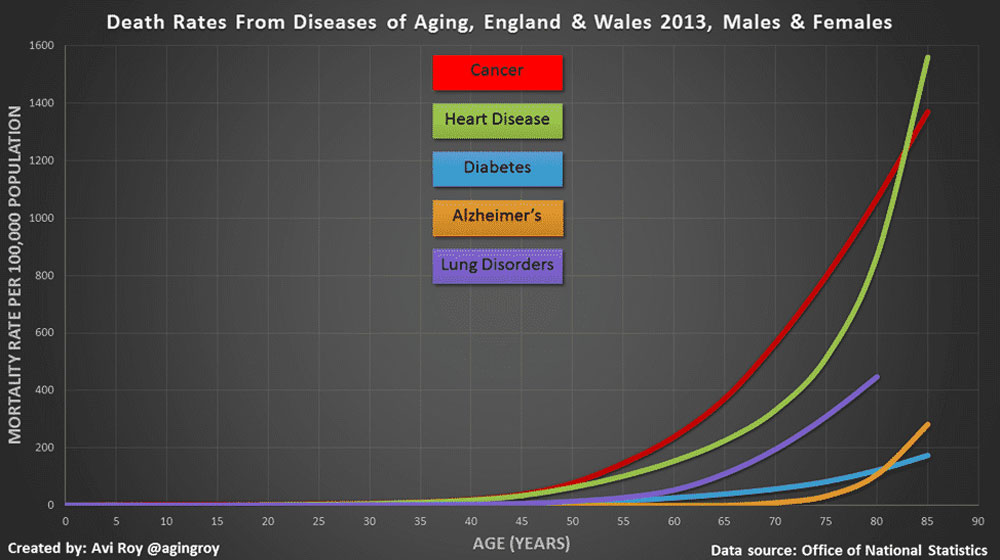What is Ageing
Ageing is essentially damage that accumulates over time, which exponentially increases the risk of the diseases that kill most people (shown below):

This ‘damage’ associated with ageing comes in essentially 9 forms, known as the hallmarks of ageing:
- Genomic instability
- Telomere attrition
- Epigenetic alterations
- Loss of proteostasis
- Deregulated nutrient-sensing
- Mitochondrial dysfunction
- Cellular senescence
- Stem cell exhaustion
- Altered intercellular communication
The hallmarks of ageing are shown in the context of the cellular and extracellular microenvironment are depicted below:
These forms of cellular damage drive the increased risk of disease, frailty, cognitive decline as well as observable signs of ageing such as grey hair, frailty and wrinkles. These hallmarks will be discussed in future posts, but there are many excellent existing reviews on this topic, such as this, this and this.
Where does this ‘damage’ come from?
The ‘damage’ (hallmarks of ageing) occurs as a by-product of normal metabolism – the biochemical reactions that keep us alive. More and more damage accumulates and eventually leads to pathology, i.e., disease. When we talk about anti-ageing we are talking about fixing the damage using an engineering approach before it accumulates to a dangerous level at which diseases emerge.
The ‘engineering’ approach of geroscience aims to combat ageing by ameliorating the damage associated with ageing before it causes pathology. The engineering approach differs from gerontology which aims to intervene by altering metabolism, but fails since metabolism is essentially too complicated for us to intervene in. It also differs from geriatrics, which aims to intervene once the damage has already accumulated and the disease is emerging but fails since it intervenes too late. Source: here.
This basic model of ageing can be understood as similar to damage accumulated by a car. In its normal use, a car accrues damage that increases the likelihood that it will break down. Anti-ageing is equivalent to maintaining a car, to prevent it from breaking down in the first place.
Anti-ageing vs current medicine
Anti-ageing is more feasible for extending healthy lifespan rather than solving the individual diseases of ageing due to Taueber’s paradox and the highly comorbid nature of age-related diseases. Basically, even if a person survives one age-related disease such as cancer, another (e.g., diabetes, cardiovascular disease) will kill them if ageing is not solved. This accounts for the much smaller increase in healthy lifespan associated with curing the diseases of ageing, such as cancer (2-3 years), versus slowing ageing itself (30+ years):
Slowing ageing is more effective than curing disease. Displayed are the calculated impacts on life expectancy for a typical 50-year-old woman from curing cancer, heart disease, or both, relative to the impact of slowing ageing. The figure was generated from data presented in Lombard et al. (2016). The coloring illustrates the hypothetical impact on health expectancy in each case, where green represents the absence of a comorbidity and red represents a severe comorbidity. Source here.
The difference between anti-ageing and current medicine is the former prevents illness by targeting the hallmarks of ageing, whereas the latter intervenes once a disease has emerged. If we compare current medical interventions associated with geriatrics with anti-ageing – the former extends unhealthy lifespan, whereas only the latter extends healthy lifespan.
Therefore, there is strong reason to think that anti-ageing will be more successful in extending healthy lifespan than the ‘sick-care’ approach of current medicine.



